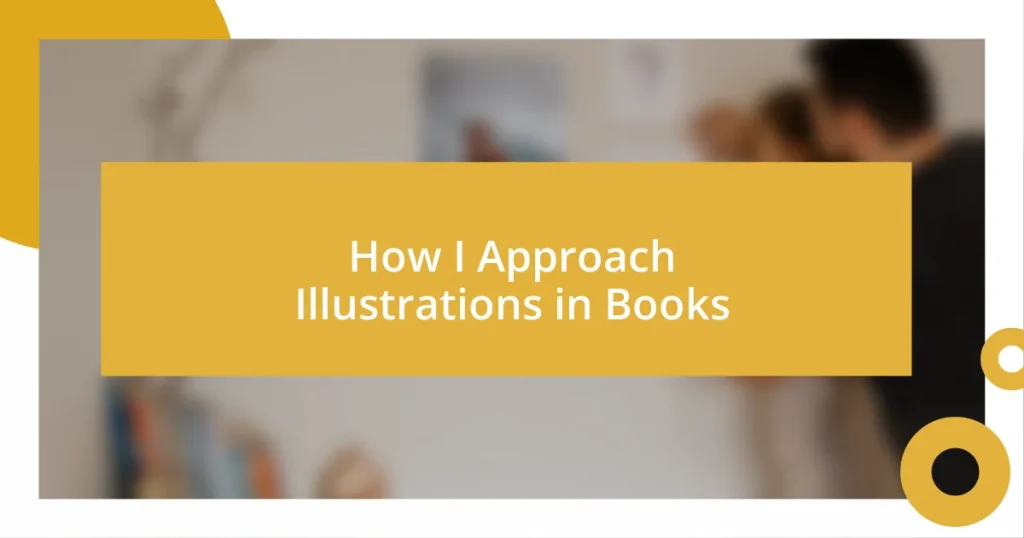Key takeaways:
- Effective illustration begins with brainstorming ideas, conducting visual research, and creating rough thumbnails to spark creativity and establish direction.
- Understanding your audience is crucial; tailoring illustration styles based on demographic factors enhances engagement and emotional connection.
- Balancing text and images augment storytelling, where the interplay of visuals with narrative can elevate the reader’s experience and evoke strong emotions.

How to Start Illustrations
When I approach starting illustrations, I often find that brainstorming ideas lays a solid foundation. I like to jot down any themes or emotions that resonate with me; it sparks a creativity that feels almost magical. Have you ever felt that surge of inspiration when a particular concept just clicks? I remember once sketching out an entire character based on a simple phrase that popped into my head during a walk.
Once I have some ideas swirling, I dive into visual research. It’s fascinating how images can ignite different feelings and ideas. I often spend time scrolling through art blogs or even social media platforms like Pinterest, collecting visuals that reflect the tone or essence of what I’m trying to convey. This method not only inspires me, but it also helps clarify the direction of my illustrations—what colors or styles might resonate best with the project.
Lastly, I find that starting with rough thumbnails can be incredibly effective. It’s like capturing the heartbeat of the illustration before fleshing it out. I scribble small, quick sketches just to get the composition right without overthinking it. Have you ever tried this technique? It really instills a sense of freedom in my work, making it less daunting as I transition into detailed illustrations.

Understanding Your Audience
Understanding your audience is one of the most critical steps in illustration work. I’ve learned that knowing who will be interacting with my illustrations shapes every decision I make, from color palettes to character design. For instance, when creating art for children, I often emphasize bright colors and playful shapes. These elements help draw in young viewers and evoke a sense of wonder. Can you recall a time when an illustration truly captured your attention? For me, it was seeing a vibrant, whimsical character that made me smile instantly.
As I delve deeper into the different audience segments, I recognize the importance of demographic factors like age, interests, and cultural background. It’s fascinating how these aspects can transform the storytelling element of an illustration. I remember designing a cover for a fantasy novel targeting young adults, and I made sure to incorporate darker shades and more intricate details; it felt like I was creating a visual narrative that spoke directly to their experiences and aspirations. When I received positive feedback from the target audience, I felt a sense of validation and excitement.
Engagement is also crucial. The more I interact with my audience, whether through social media or direct feedback, the better I can grasp their preferences. An instance that sticks to my mind was when I posted a poll to decide between two character designs. The response surprised me, and I realized that involving my audience in the creative process can lead to illustrations that resonate even more deeply.
| Audience Segment | Illustration Style |
|---|---|
| Children | Bright colors, playful shapes |
| Young Adults | Darker shades, intricate details |

Developing a Unique Style
Developing a unique style has been a journey for me, where experimentation plays a vital role. There was a time when I tried to mimic the styles of my favorite illustrators, thinking it would help me find my voice. But as I began to explore my own interests and techniques, I realized that my flair emerged when I let loose and created freely. I still remember the thrill of blending unexpected color combinations on a piece; it felt like stepping into a vibrant world that was entirely my own.
Embracing imperfections is another key aspect of developing a unique style. I used to strive for perfection in my sketches, but I’ve learned that the little quirks and flaws often give a piece character. It reminds me of a specific project where I allowed myself to draw with a more expressive, spontaneous hand. The result? A set of illustrations that felt alive and relatable. I think these elements serve as a connection to viewers, making them feel as though they’re part of my creative process.
- Experiment with various mediums (watercolors, digital, pencil).
- Embrace your quirks and imperfections; they differentiate you.
- Collect and curate inspiration but always strive to make it your own.
- Trust your instincts over current trends; they win out in the long run.

Choosing the Right Techniques
Choosing the right techniques in illustration often comes down to experimenting with different styles and mediums. I remember when I first picked up watercolors, feeling that exhilarating rush of fear and excitement. The unpredictability of the paint blending on paper taught me so much about letting go and embracing spontaneity. Have you ever had that moment where a particular medium just clicked for you? For me, it felt like uncovering a hidden talent I never knew existed.
Another essential aspect is aligning techniques with the emotional tone of the story. I once illustrated a children’s book about overcoming fears, and I chose softer brush strokes and pastel colors to convey a sense of safety and comfort. It was amazing how just a slight change in technique could shift the emotional impact of the illustrations. How do you think the visuals can elevate a story’s theme? I believe the right technique can create a visual dialogue that resonates with what the reader feels.
In addition, I often consider practical factors like time constraints and project requirements. There was a project I worked on where I had to crank out character sketches quickly. Rather than getting caught up in intricate details, I learned to use simple line drawings to convey personality effectively. This experience reminded me that sometimes less truly is more. Have you ever felt pressure to simplify your work? It taught me that adapting my technique to suit the project’s needs can often enhance the final result.

Balancing Text and Images
Finding the right balance between text and images is crucial for creating a compelling visual narrative in book illustrations. I often reflect on a time when I worked on a project that featured whimsical characters and playful stories. I noticed that when the text was too dense, it overshadowed the illustrations, leading to a disconnect. So, I started experimenting with lighter text that flowed seamlessly with the images, allowing readers to feel fully immersed in both elements. Have you ever found yourself skipping text just to engage with stunning visuals? I think harmonizing them creates a more enriching experience.
The interaction between text and image can evoke different emotions in readers. I recall a children’s book I illustrated, where the imagery of a lonely tree lived beside comforting words. It was such a powerful moment when I realized that by using larger illustrations and allowing more white space around the text, I could amplify the loneliness in the tree’s story. This approach encouraged readers to pause and truly feel what the visuals conveyed. Isn’t it fascinating how adjustments in layout can completely change the mood?
Ultimately, I believe it’s all about creating a dialogue between illustrations and text. In one of my favorite projects, I carefully arranged images that complemented each paragraph, allowing the illustrations to guide the reader’s thoughts rather than just decorate the page. Each turn of the page felt like a conversation, keeping the reader engaged. This interplay is something I strive to achieve in every project—ensuring neither element overpowers the other, but instead, they work together to weave a more cohesive story. Do you have any techniques for achieving this balance?

Tips for Effective Storytelling
Integrating visual storytelling requires a keen understanding of the narrative arc. I remember collaborating on a graphic novel where each chapter had to build tension leading to a climactic moment. By varying my illustration styles—using darker hues and jagged lines to intensify conflict—I was able to guide the reader’s emotions seamlessly. Have you ever noticed how a shift in illustration style can change your anticipation for a story’s outcome? It’s almost like the visuals are crafting their own plot twists alongside the text.
Another tip is to use visual metaphors to deepen storytelling. In one project, I illustrated a character’s journey of self-discovery through the imagery of a winding path. Each twist and turn in the path represented a different challenge he faced, which made readers reflect on their own journeys. This layer of meaning adds richness to the narrative, drawing readers in even more. How often do you find yourself connecting personally with visual symbols in a story?
Lastly, it’s essential to consider pacing when storytelling through illustrations. When I illustrated a suspenseful scene, I intentionally slowed down the visual tempo by using more panels on a page, allowing readers to linger in that moment. This technique created tension and drew out the emotions associated with the unfolding events. Have you tried manipulating pacing in your storytelling? I believe finding that rhythm can make all the difference in keeping readers on the edge of their seats.

Finalizing and Presenting Illustrations
When finalizing illustrations, I like to step back and view the entire layout as a finished piece. Recently, during the final review of a children’s book, I realized that one particular illustration was competing too much with the accompanying text. After a few adjustments, like softening the colors and adding a subtle shadow, the harmony between the visuals and words enhanced the overall storytelling. Have you ever had a moment when a simple tweak transformed your artwork?
Presenting illustrations effectively can involve considering how they interact with the page design. I remember working on a fantasy novel where each chapter opener featured a striking full-page illustration. These illustrations didn’t just serve as a visual cue; they set the tone for the entire chapter, drawing readers into the world before they even read a word. Have you thought about how such immersive presentations can pull readers deeper into the narrative?
Finally, it’s vital to share illustrations in a way that helps them shine. I once participated in a book launch event, showcasing my artwork alongside the text. Engaging with the audience about the details of each illustration, like the emotional backstory behind a character’s expression, created a deeper appreciation for the narrative. I left the event feeling energized by the enthusiasm from the readers. Isn’t it rewarding to connect with an audience over the illustrations you’ve poured your heart into?















